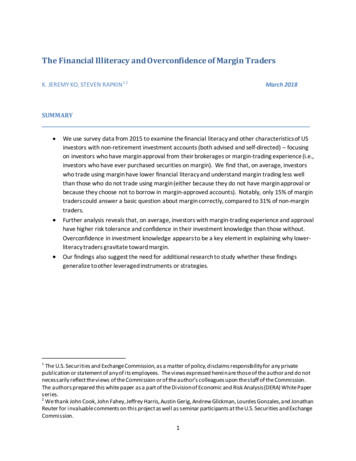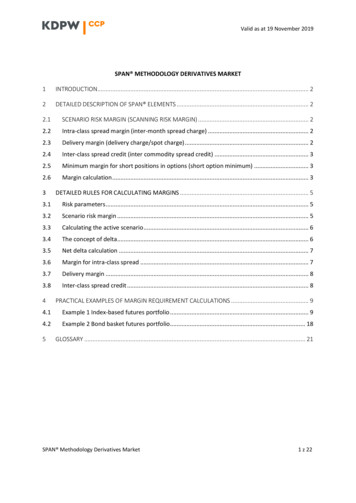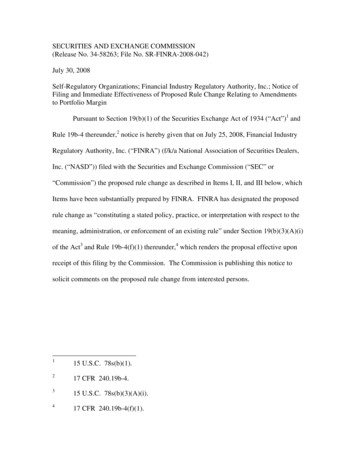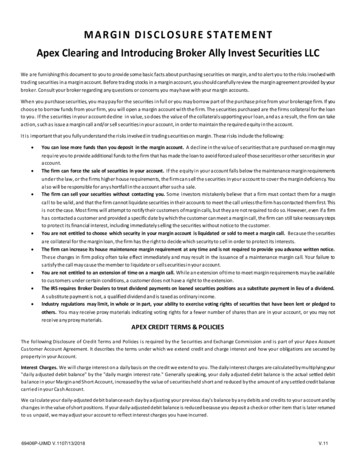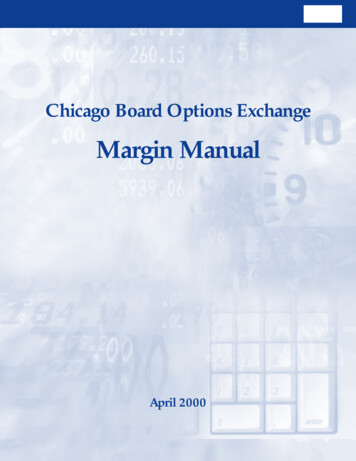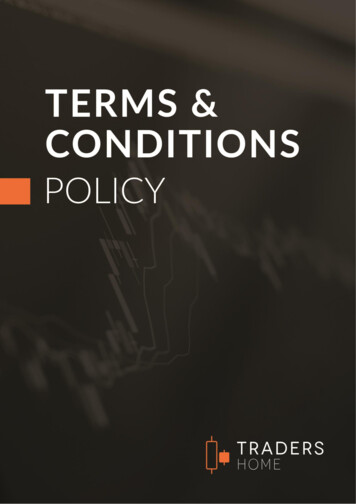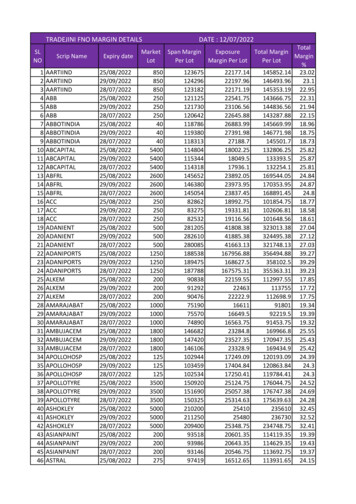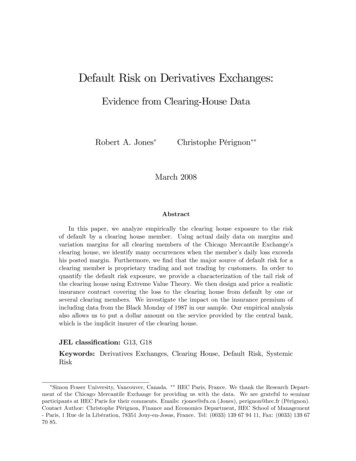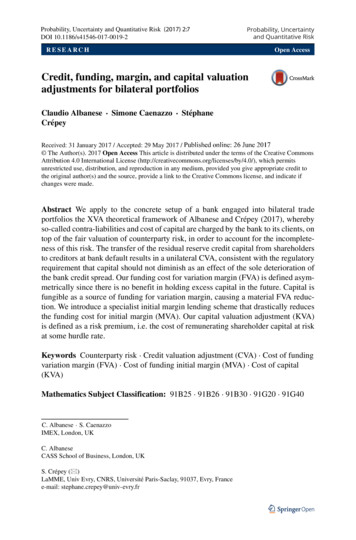
Transcription
Probability, Uncertainty and Quantitative Risk (2017) 2:7DOI 10.1186/s41546-017-0019-2Probability, Uncertaintyand Quantitative RiskRESEARCHOpen AccessCredit, funding, margin, and capital valuationadjustments for bilateral portfoliosClaudio Albanese · Simone Caenazzo · StéphaneCrépeyReceived: 31 January 2017 / Accepted: 29 May 2017 / The Author(s). 2017 Open Access This article is distributed under the terms of the Creative CommonsAttribution 4.0 International License (http://creativecommons.org/licenses/by/4.0/), which permitsunrestricted use, distribution, and reproduction in any medium, provided you give appropriate credit tothe original author(s) and the source, provide a link to the Creative Commons license, and indicate ifchanges were made.Abstract We apply to the concrete setup of a bank engaged into bilateral tradeportfolios the XVA theoretical framework of Albanese and Crépey (2017), wherebyso-called contra-liabilities and cost of capital are charged by the bank to its clients, ontop of the fair valuation of counterparty risk, in order to account for the incompleteness of this risk. The transfer of the residual reserve credit capital from shareholdersto creditors at bank default results in a unilateral CVA, consistent with the regulatoryrequirement that capital should not diminish as an effect of the sole deterioration ofthe bank credit spread. Our funding cost for variation margin (FVA) is defined asymmetrically since there is no benefit in holding excess capital in the future. Capital isfungible as a source of funding for variation margin, causing a material FVA reduction. We introduce a specialist initial margin lending scheme that drastically reducesthe funding cost for initial margin (MVA). Our capital valuation adjustment (KVA)is defined as a risk premium, i.e. the cost of remunerating shareholder capital at riskat some hurdle rate.Keywords Counterparty risk · Credit valuation adjustment (CVA) · Cost of fundingvariation margin (FVA) · Cost of funding initial margin (MVA) · Cost of capital(KVA)Mathematics Subject Classification: 91B25 · 91B26 · 91B30 · 91G20 · 91G40C. Albanese · S. CaenazzoIMEX, London, UKC. AlbaneseCASS School of Business, London, UKS. Crépey ( )LaMME, Univ Evry, CNRS, Université Paris-Saclay, 91037, Evry, Francee-mail: stephane.crepey@univ-evry.fr
Page 2 of 26C. Albanese et al.JEL Classification: D52 · G13 · G24 · G28 · G33 · M41AbbreviationsCA: Contra-assets (or their valuation)CDS: Credit default swapCL: Contra-liabilities (or their valuation)CR: counterparty risk (or its valuation)CVA: Credit valuation adjustmentCVACL : Contra-liability component of a unilateral CVADVA: Debt valuation adjustmentEC: Economic capitalES: Expected shortfall at the confidence level 97.5%FDA: Funding debt adjustmentFTDCVA: First-to-default CVAFTDDVA: First-to-default DVAFTP: Funds transfer priceFVA: Funding valuation adjustmentIM: Initial margin (with PIM and RIM for IM posted and received by the bank)KVA: Capital valuation adjustmentMDA: Margin debt adjustmentMtM: Mark-to-market of a portfolio when all XVAs are ignoredMVA: Margin valuation adjustmentOIS: Overnight index swapRC: Reserve credit capitalRF: Reserve funding capitalRM: Risk margin (or KVA)SCR: Shareholder capital at riskVM: Variation marginXVA: Generic “X” valuation adjustmentIntroductionAlbanese and Crépey (2017) developed an XVA theoretical framework based ona capital structure model acknowledging the impossibility for a bank to replicatejump-to-default related cash flows. Their approach results in a two-step XVAmethodology.First, the so-called contra-assets (CA) are valued as the expected counterpartydefault losses and funding expenditures. These expected costs can be represented asthe sum between the valuation, dubbed CR, of counterparty risk to the bank as awhole (or “fair valuation” of counterparty risk), plus an add-on compensating bankshareholders for a wealth transfer to creditors, corresponding to the so-called contraliabilities (CL), triggered by the impossibility for the bank to hedge its own jump-todefault exposure.
Probability, Uncertainty and Quantitative Risk (2017) 2:7Page 3 of 26Second, a KVA risk premium is computed as the cost of a sustainable remuneration of the shareholder capital at risk earmarked to absorb the exceptional (beyondexpected) losses due to the impossibility for the bank to replicate counterpartyjump-to-default cash flows.The all-inclusive XVA add-on appears asCA KVA CR CL KVA.(1)This formula is applied for every new deal or tentative deal, incrementally ona run-off basis in the portfolios with and without the new deal, in order to derivethe so-called funds transfer price (FTP) of the deal. The corresponding pricingpolicy is interpreted as the cost for the bank of the possibility to run-off its portfolio, in line with shareholder interest, from any future time onward if wished.This “soft landing” option is key from a regulator point of view, as it guaranteesthat the bank should not be tempted to go into snowball or Ponzi kind of schemeswhere always more trades are entered for the sole purpose of funding previouslyentered ones.In the present paper we apply this framework to the concrete setup of a bankengaged in bilateral trade portfolios. In this context, the discounted expectation oflosses due to the default of counterparties or of the bank itself are respectively knownas CVA (credit valuation adjustment) and DVA (debt valuation adjustment). Counterparty risk mitigants include the variation margin (VM), tracking the mark-to-marketof client portfolios, and the initial margin (IM) set as a cushion against gap risk, whichis the risk of slippage between the portfolio and its variation margin during liquidation periods. The cost of funding cash collateral for the variation margin is known asfunding valuation adjustment (FVA), while the cost of funding segregated collateralposted as initial margin is the margin valuation adjustment (MVA). Contra-liabilitycounterparts of the FVA and the MVA arise as the FDA (funding debt adjustment) andthe MDA (margin debt adjustment). The contra-liability component of a unilateralCVA is dubbed CVACL .The main contributions of this paper are the concrete equations of Proposition 4.1for the corresponding CA CVA FVA MVA and KVA metrics, the XVA algorithm and the numerical results on real datasets. The refined FVA in (29) captures theintertwining of the FVA and economic capital, which leads to a significantly lowerFVA as a result of the fungibility of economic capital (on top of reserve capital) asa source of funding for variation margin. The alternative MVA formula (30) showshow a specialist initial margin lending scheme may drastically reduce the fundingcost for initial margin (MVA).Assumptions are emphasized in bold throughout the paper.XVA conceptual frameworkThis section provides a brief recap of the XVA methodology that arises fromAlbanese and Crépey (2017).We consider a bank made of four different floors. The intermediate floors(CVA and Treasury) are in charge of filtering out counterparty risk and its risky
Page 4 of 26C. Albanese et al.funding implications from the contracts with the clients of the bank. In the caseof the Treasury there are two desks on the same floor (sharing the same bankaccount): the FVA desk, in charge of funding the VM, and the MVA desk, incharge of funding the IM. The upper floor is the management in charge of theKVA payments to the shareholders, i.e. of the dividend distribution policy ofthe bank. Thanks to the upper floors of the bank, the traders of the bottom(dubbed clean) floor can focus on the management of the market risk of theirrespective business lines, ignoring counterparty risk and its capital and fundingimplications.CVA payments by clients flow into a a reserve credit (RC) account used by theCVA desk for coping with expected counterparty default losses. FVA and MVApayments flow into a reserve funding (RF) account used by the Treasury for coping with expected funding expenditures. KVA payments flow into a risk margin(RM) account from which they are gradually released by the bank management toshareholders as a remuneration for their capital at risk. We assume that all bankaccounts are continuously reset to their theoretical target level. Therefore, therelations RC CVA and RF FVA MVA, hence RC RF CVA FVA MVA CARM KVA(2)hold at all times. In particular, much like with futures, the trading position of thebank (clean desks, CVA desk and Treasury altogether) is reset to zero at all times, butit generates a non-vanishing (unless perfectly hedged) trading loss-and-profit process L, or loss process for brevity. The KVA payments by the management of thebank come on top of the trading gains as an additional contribution to shareholderdividends, which corresponds to risk compensation.In order to focus on counterparty risk and XVA analysis, we assume throughoutthe paper that the clean desks of the bank are perfectly hedged, i.e. their tradingloss is zero. Hence, only the counterparty risk related cash flows remain and we canconcentrate on the activity of the CVA floor, the Treasury and the management of thebank.The default of the bank is modeled as a totally unpredictable time τ calibrated tothe bank CDS spread, which we view as the most reliable and informative credit dataregarding anticipations of markets participants about future recapitalization, government intervention, etc. Assuming instantaneous liquidations upon defaults, the timehorizon of the model is τ̄ τ T , where T is the final maturity of the portfolio.We assume that, at the bank default time τ, an exceptional (e.g. operational)loss occurs and wipes out any residual risk capital (shareholder capital at riskand risk margin) and reserve funding capital, whereas the residual credit capitalis transferred to creditors, who need it for coping with counterparty defaults afterthe bank default (in which case, creditors must mark to market a loss on the derivativeposition of the bank; similarly, if the creditors unwind the position of a counterparty,they have to recognize a CVA discount.We consider a pricing stochastic basis ( , G, Q), with model filtrationG (Gt )t R and probability measure Q, such that all processes of interest are G
Probability, Uncertainty and Quantitative Risk (2017) 2:7Page 5 of 26adapted and all random times of interest are G stopping times. The correspondingexpectation and conditional expectation are denoted by E and Et . All value and priceprocesses are modeled as semimartingales in a càdlàg version.We denote by r a G progressive OIS rate process, where OIS rate stands forovernight indexed swap rate, which is together the best market proxy for a riskfree rate and t the reference rate for the remuneration of cash collateral. We writeβt e 0 rs ds for the corresponding risk-neutral discount factor. We denote byJ 1[0,τ ) the survival indicator process of the bank. For any left-limited process Y,we denote by τ Y Yτ Yτ the jump of Y at τ and by Y τ J Y (1 J )Yτ the process Y stopped before τ , so thatdYt dYtτ ( τ Y ) dJt , 0 t τ̄ .(3)We say that the process Y is stopped before τ if Y Y τ .ValuationWe denote by C , F and M the cumulative streams of counterparty exposure cashflows and of VM and IM related risky funding cash flows. By risky funding cashflows we mean the funding cash flows other than risk-free accrual of the bankaccounts and risk-free remuneration of the collateral. Cash flows are valued by theirrisk-free discounted (G, Q) conditional expectation, which is assumed to existfor all the cash flows that appear in the paper. Risky funding is implemented inpractice as the stochastic integral of predictable hedging ratios against funding assets.Under the above valuation assumption for cash flows, the value process of eachof these assets is a martingale modulo risk-free accrual. Hence F and M are(G, Q) martingales. Moreover the trading desks of the bank is supposed to beshareholder-centric, in the sense that traders only value the cash flows that affectthe shareholders of the bank, i.e. the cash flows received by the bank prior itsdefault or the transfer from shareholders to creditors of the residual value ontheir trading account at the bank default time τ .Proposition 2.1 We have, for 0 t τ̄ ,CAt CVAt FVAt MVAt , where τ̄ CVAt Etβt 1 βs d Csτ βτ 1 βs 1{τ T } CVAτ tτ̄ τ̄βt 1 βs d Fsτ , MVAt Etβt 1 βs d Mτs ,tt CLt Et βt 1 βτ 1{τ T } ( τ C ) Et βt 1 βτ 1{τ T } CVAτ Et βt 1 βτ 1{τ T } ( τ F ) Et βt 1 βτ 1{τ T } ( τ M) , τ̄βt 1 βs d Cs .CRt EtFVAt Ett(4)
Page 6 of 26C. Albanese et al.The trading loss process L of the bank is a risk-neutral local martingale such thatβt dLt d (βt CAt ) βt d Ctτ d Ftτ d Mτt , 0 t τ̄ ,(5)starting from some initial value L0 z unknown but immaterial, as only thefluctuations of L matter in capital computations.Proof In (4) the CA equations express the valuation of the cash flows that affecteach of the trading desks before bank default (CVA, FVA and MVA desks, as cleandesks disappear from the picture under our perfect clean hedge assumption). Moreover, the terminal cash flow 1{τ T } CVAτ in the CVA equation corresponds to thefreezing of the residual credit capital RCτ CVAτ (cf. (2)), which is transferredfrom bank shareholders to creditors in case of default of the bank. This results in aCVA terminal condition CVAT 0 on {T τ } and τ CVA 0 on {τ T }, asembedded in the CVA equation in (4). This comes in contrast with the terminal conditions FVAτ̄ MVAτ̄ 0, which hold by our assumption that the residual fundingcapital is used for absorbing the exceptional loss of the bank at time τ . In line withthe respective definitions (see “Introduction” section), we have CRt Ettτ̄βt 1 βs (d Cs d Fs d Ms ) ,CLt CAt CRt ,from which the expressions stated for CR and CL in (4) result by the martingaleproperties of F and M and the CA equations in (4).Note that the CVA, FVA and MVA equations in (4) are equivalent to theabove-mentioned terminal conditions, alongside with martingale conditions on thefollowing processes on [0, τ̄ ], which correspond to the trading loss processes ofthe corresponding trading desks:βt dLcva d βt CVAτt βt d Ctτ tf vaβt dLtβt dLmvat d(βt FVAt ) βt d Ftτ (6)d(βt MVAt ) βt d Mτt ,Under our perfect clean hedge assumption, these add-up to the trading loss L of thebank (the KVA payments by the management of the bank are not part of the tradinglosses but risk compensation to shareholders). This yields the Eq. (5) for L (notingthat the CVA process is stopped before τ ).We emphasize that Proposition 2.1 is derived from a pure valuation perspective.In most references in the literature, XVA equations are based on hedging arguments.The reason is that previous XVA works were not considering KVA yet. Under ourapproach, the KVA is the risk premium for the market incompleteness related to the
Probability, Uncertainty and Quantitative Risk (2017) 2:7Page 7 of 26impossibility for the bank of replicating counterparty default losses. For consistency,our KVA treatment requires a pure valuation (as opposed to hedging) treatment ofcontra-assets and contra-liabilities.Note that the CVA formula in (4) is in fact a fixed-point equation, which remainsto be shown well posed in a suitable space of processes. Even if not visible at thatstage, this remark also applies to the FVA equation, as the risky funding cash flowsF typically depend on the FVA itself (cf. e.g. (17), where CA includes an FVA term).PricingIn the setup of Albanese and Crépey (2017), valuation is not price, which entails anadditional deduction in the form of the KVA risk premium devised by the management of the bank in order to compensate the shareholders for their capital at risk. Inthe absence of reliable information about it at the time horizon of XVA computations(which can be as long as decades), we assume that the historical probability measure P required for capital calculations coincides with the pricing measure Q,the discrepancy between P and Q being left to model risk.Since L fluctuates over time according to (5), economic capital EC ECt (L)needs to be dynamically earmarked by the bank in order to absorb exceptional losses(beyond the expected level of the losses already accounted for by reserve capital). Asshown in Albanese and Crépey (2017, Sections 4.3, 6.5 and 8.1) the size of the riskmargin (RM) account required for remunerating shareholder capital at risk (SCR) ata constant hurdle rate h throughout the life of the portfolio is KVAt hEtτ̄e st(ru h)duECs (L)ds, t [0, τ̄ ],(7)βs 1 βu dLu conditional on Gs ,(8)twhere ECs (L) is computed based on a 97.5% expected shortfall (ES) ofss 1which we denote by ESs (L).The “ h” in the discount factor in (7) reflects the fact that the risk margin RM KVA (cf. (2)) is loss-absorbing, hence part of EC, so that shareholder capital at riskreduces to SCR EC KVA. As a further consequence of this loss-absorbingfeature of the risk margin, an increase of economic capital above ES may be requiredin order to ensure the consistency condition KVA EC, i.e. EC KVA SCR 0.This results in a fixed-point problem (7), whereECt (L) max (ESt (L), KVAt ) , t [0, τ̄ ].(9)Remark 2.1 For KVA computations entailing capital projections over decades, anequilibrium view based on Pillar II economic capital (EC) is more attractive than the
Page 8 of 26C. Albanese et al.ever-changing Pillar I regulatory charges supposed to approximate it (see Pykhtin(2012)). However, Pillar I regulatory capital requirements could be incorporated intoour approach, if desired, by replacing ES ESt (L) in (9) by its maximum with theregulatory capital pertaining to the portfolio.Bilateral trading cash flowsIn this paper, we assume that the bank is engaged in bilateral trading of a derivativeportfolio split into several netting sets corresponding to counterparties indexed byi 1, . . . , n, with default times τi and survival indicators J i 1[0,τi ) . The bank isalso default prone, with default time τ and survival indicator J 1[0,τ ) .We suppose that all these default times are positive and admit a finite intensity. In particular, defaults occur at any given G predictable stopping time with zeroprobability, so that such events can be ignored in all computations.Exposures at defaultsLet MtMit be the mark-to-market of the i-th netting set, i.e. the trade additive riskneutral conditional expectation of future discounted promised cash flows, ignoringcounterparty risk and assuming risk-free funding. Let VMit denote the correspondingvariation margin, counted positively when received by the bank. Hence,Pti MtMit VMit(10)is the net spot exposure of the bank to the i-th netting set. In addition to the variationmargin VMit that flows between them, the bank and counterparty i post respectiveinitial margins PIMi and RIMit in some segregated accounts.In practice, there is a positive liquidation period, usually a few days, between thedefault of a party and the liquidation of its portfolio. The gap risk of slippage of MtMitand of unpaid contractual cash flows during the liquidation period is the motivationfor the initial margin.A positive liquidation period is explicitly introduced in Armenti and Crépey(2017a, b) and Crépey and Song (2016) (see also Brigo and Pallavicini (2014)) andinvolves introducing the random variablesMtMiτi δt δMtMiτi δt VMiτi ,(11)where δt is the length of the liquidation period and δMtMiτi δt is the accrued valueof all cash flows owed by the counterparty to the bank during the liquidation period.To simplify the notation in this paper, we take the limit as δt 0 and approximateii τ , and therefore (11) by Qiτ MtM τ VMiτ , for δMtMiwith MtMMtMiτi δtτi δtiiiii . A related issue is wrong-way risk, i.e. the riska suitable G optional process MtM
Probability, Uncertainty and Quantitative Risk (2017) 2:7Page 9 of 26of adverse dependence between the counterparty exposure and the credit risk of theparties. As illustrated in Crépey and Song (2016), this impact can also be captured inthe modeling of the Qiτi .We denote by R and Ri the recovery rate of the bank and of counterparty i, fori 1, . . . , n.Lemma 3.1 The exposure of the bank to the default of counterparty i 1, . . . , nat time τi τ T is (1 Ri ) Qiτi RIMiτi(12).The exposure of counterparty i 1, . . . , n to the default of the bank at time τ τi T is (1 R) Qiτ PIMiτ(13).Proof By symmetry, it is enough to prove (12). Let C i VMi RIMi and i Qiτi RIMiτii τ Cτi MtMii .When counterparty i defaults, the bank receives from counterparty i i τ CτiCτi i Ri MtMiii τ Cτi MtMii i τ 1 i 0 Cτi Ri i . 1 i 0 MtMiiAlso accounting for the unwinding of the clean hedge of netting set i at the timeof liquidation of counterparty i, the loss of the bank in case of default of counterpartyi appears as (assuming τi τ )ii τ 1 i 0 MtM τ 1 i 0 Cτi Ri iMtMiiii τ Cτi Ri i (1 Ri ) i . 1 i 0 MtMiiAs an immediate corollary to Lemma 3.1, denoting by δ t a Dirac measure at time t:Lemma 3.2 The cumulative cash flow stream C of counterparty exposures satisfies, for 0 t τ̄ ,d Ct (1 Ri ) Qiτi RIMiτi id Ctτ Jτi (1 R) Qiτ PIMiτδ τi(dt) δ τ(dt)iJτi (1 Ri ) Qiτi RIMiτi δ τi (dt)i( τ C ) Jτi (1 R) Qiτ PIMiτ δ τ (dt)i (1 Ri ) Qiτi RIMiτi δ τi (dt).i;τi τ(14)
Page 10 of 26C. Albanese et al.Margining and funding schemesVariation margin typically consists of cash that is re-hypothecable, meaning thatreceived variation margin can be reused for funding purposes, and is remunerated atOIS by the receiving party. Initial margin typically consists of liquid assets depositedin a segregated account, such as government bonds, which naturally pay coupons orotherwise accrue in value. The poster of initial margin receives no compensation,except for the natural accrual or coupons of its collateral.The trading strategy of the bank needs funding for raising variation margin andinitial margin that need to be posted as collateral. As happens in practice in the currentregulatory environment, the clean hedge of the derivative portfolio of the bank isassumed to be with other financial institutions and attracts variation margin at zerothreshold (i.e. is fully collateralized),by the bank so that the variation margin posted on its hedge is constantly equal to i J i MtMi . Hence, the bank posts i J i MtMias VM on the hedge and receives i J i VMi as VM on client trades, which nets toJti MtMit iJti VMit iJti Pti .iMoreover, the bank can use reserve capital as variation margin. Note that themarginal cost of capital for using capital as a funding source for variation marginis nil, because when one posts cash against variation margin, the valuation of thecollateralized hedge is reset to zero and the total capital amount does not change. If,instead, the bank were to post capital as initial margin, then the bank would record a“margin receivable” entry on its balance sheet, which however cannot contribute tocapital since this asset is too illiquid and impossible to unwind without unwinding allunderlying derivatives. Hence, capital can only be used as VM, while it seems thatIM must be borrowed entirely.Under our continuous reset assumption (2), the amount (RC RF) of reservecapital that can be used as VM coincides at all times with the theoretical CA value.The cash held by the bank, whether borrowed or received as variation margin, isdeemed fungible across netting sets in a unique funding set. In conclusion, (VM funding needs)t Jti Pti CAt, (IM funding needs)t iJti PIMit .i(15)We assume that the bank can invest at the OIS rate rt and obtain unsecuredfunding at rate (rt λt ) for funding VM and (rt λ̄t ) for funding IM, via twobonds of different seniorities issued by the bank, with respective recoveries R and R̄.Given our standing valuation setup, it must hold thatλ (1 R)γ , λ̄ (1 R̄)γ ,where γ is the risk-neutral default intensity process of the bank.(16)
Probability, Uncertainty and Quantitative Risk (2017) 2:7Page 11 of 26We denote by dμt γt dt dJt the compensated jump-to-default martingale ofthe bank.Lemma 3.3 The cumulative cash flow streams F and M of VM and IM relatedrisky funding cash flows satisfy, for 0 t τ̄ , d Ft (1 R)iiJt Pt i d Ftτ Jti Ptii CAt dμt , d Mt 1 R̄ CAtλt dt,d Mτt ( τ F ) (1 R)Jτi Pτi λ̄t dti , ( τ M) 1 R̄ CAτ dμti Jti PIMitiJt PIMit iJτi PIMiτ .i(17)Proof In view of the above description, we haved Ftτ (VM funding needs)t λt dt, d Mτt (IM funding needs)t λ̄t dt( τ F ) (1 R)(VM funding needs)τ , ( τ M) 1 R̄ (IM funding needs)τ ,i.e.d Ft (VM funding needs)t (λt dt (1 R)dJt )d Mt (IM funding needs)t λ̄t dt (1 R̄)dJt .Hence, given (16),d Ft (1 R)(VM funding needs)t dμt , d Mt 1 R̄ (IM funding needs)t dμt .In view of (15), this yields (17).Bilateral trading XVA formulasWe work under the technical assumption that each of the martingales Et βτi 1{τi T } (1 Ri ) Qiτi RIMiτi , i 1, . . . , n, does not jump at time τ .(18)
Page 12 of 26C. Albanese et al.This holds, in particular, when G is modeled as the progressive enlargement of areference filtration F by the bank default time τ, in a basic immersion setup where(F, Q) martingales are (G, Q) martingales without jump at time τ (see the comments before Section 3 in Duffie et al. (1996) or in Collin-Dufresne et al. (2004, page1379) and see the comments following (3.22) and (H.3) or the remarks followingProposition 6.1 in Bielecki and Rutkowski (2001)). The more general case, whereimmersion hypothesis is violated and the technical condition (18) does not hold, canalso be considered, by dealing explicitly with the underlying enlargement of filtrationissue. This is done in Albanese and Crépey (2017).Proposition 4.1 yields a complete specification of all XVA metrics and ofthe loss process L required as input data in the KVA computations, in thecase of a bank engaged in bilateral trade portfolios. It identifies the FTP (allinclusive XVA add-on to the entry price) of a new trade as its incremental(CVA FVA MVA KVA), the difference with the complete market formula(FTDCVA FTDDVA) (cf. “Connection with the Duffie and Huang (1996) formula”section) being explained by the CL wealth transfer and the KVA risk premium, whichare triggered by the impossibility for the bank to replicate jump-to-default exposures.We denote by: Lp , p 1, the space of progressively measurable processes X over [0, τ̄ ] such τ̄pthat E 0 Xt dt ,S2 , the space of adapted càdlàg processes Y over [0, τ̄ ] such thatE supt [0,τ̄ ] Yt2 .All our XVA processes are sought for in S2 . In particular, we assume that the CVAequation in (4) has at most one solution in S2 , as can be established in the invariancebank default time framework of Albanese and Crépey (2017).Proposition 4.1 Assuming that r is bounded from below, that the CVAand MVA processes in (19) are in S2 , and that the processes r, λ, and i i λare in L2 :i J P CVA MVA(i) Contra-assets are given as τ̄ βt 1 βτi (1 Ri ) Qiτi RIMiτi Etβt 1 βs λ̄sJsi PIMis dsCAt Et{i; t τi T } tCVAt τ̄ Et t i MVAt βt 1 βs λsJsi Psii CVAs MVAs FVAs ds , 0 t τ̄ , FVAt(19)where FVA is the unique solution in S2 to the backward SDE (BSDE) defined bythe last line.
Probability, Uncertainty and Quantitative Risk (2017) 2:7Page 13 of 26(ii) Contra-liabilities are given as CLt Et βt 1 βτi 1{t τ τi T } (1 R) Qiτ PIMiτ i FTDDVAt i CVACLt βt 1 βτ 1{t τ T } (1 R) Et Jτi Pτi CAτ i FDAt FVAt Etii FTDDVAtβt 1 βτi 1{t τ τi T } (1 Ri ) Qiτi RIMiτi Et βt 1 βτ 1{t τ T }1 R̄, 0 t τ̄ .i Jτi PIMiτ MDAt MVAt(20)(iii) The value of counterparty risk to the bank as a whole is given by Et βt 1 βτi 1{t τi τ̄ } (1 Ri ) Qiτi RIMiτiCRt i FTDCVAt iFTDCVAit Et βt 1 βτi 1{t τ τi T } (1 R) Qiτ PIMiτ i FTDDVAt i , 0 t τ̄ , FTDDVAit(21)i.e. we haveCVA FVA MVA CACLFTDCVA FTDDVA FTDDVA CVA FDA MDA , CR(22)CLwhere the different terms are detailed in (19), (20), and (21).(iv) The bank trading loss process L satisfies the following forward SDE on [0, τ̄ ]:L0 z (the accrued trading loss of the bank at time 0) and, for t (0, τ̄ ],dLt dCAt Jτi (1 Ri ) Qiτi RIMiτii λtδ τi (dt) Jti Ptii CAt λ̄tJti PIMit rt CAt dt.i(23)
Page 14 of 26C. Albanese et al.(v) Assuming the ensuing ES ESt (L) process (8) in L2 , KVA is the uniquesolution in S2 to the following BSDE: τ̄KVAt hEte st(ru h)dumax (ESs (L), KVAs ) ds, t [0, τ̄ ].(24)t(vi) The all-inclusive XVA add-on to the entry price for a new deal, which we callfunds transfer price (FTP), appears asFTP CVA FVA MVA KVA Risk premium CA FTDCVA FTDDVA (25) CRCL FTDDVA CVA FDA MDA KVA , Risk premium CLcomputed on an incremental run-off basis, where all the underlying XVA metricsas well as the processes L to be used as input data in the economic capital andKVA computations are defined as in parts (i) through (v) relative to the portfolioswith and without the new deal.Proof (i) Denoting by UCVA (for unilateral CVA) the expression stated in (19)for the CVA, we have, on {t τ } : Et βτ 1{t τ T } UCVAτ Et βτ 1{t τ T } lim UCVAss τ Et βτ 1{t τ T } lim Ess τβs 1 βτi (1 Ri ) Qiτi RIMiτi{i; s τi T } Et βτ 1{t τ T }limi s τJsi βs 1 EsJτi βτ 1 Eτ Et βτ 1{t τ T } βτi 1{τi T } (1 Ri )iβτi (1 Ri ) Qiτi RIMiτi{i; t τ τi T }Qiτi RIMiτi iJτ Eτ βτi 1{τi T } (1 Ri ) Qiτi RIMiτi Et 1{t τ T } βτi 1{τi T } (1 Ri ) Qiτi RIMiτii Et ,
Probability, Uncertainty and Quantit
the funding cost for initial margin (MVA). Our capital valuation adjustment (KVA) is defined as a risk premium, i.e. the cost of remunerating shareholder capital at risk at some hurdle rate. Keywords Counterparty risk ·Credit valuation adjustment (CVA) ·Cost of funding variation margin (FVA) ·Cost of funding initial margin (MVA) ·Cost of .
